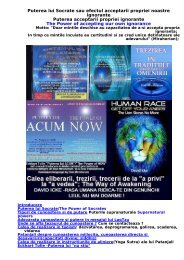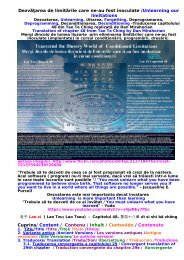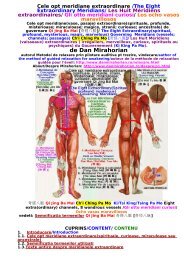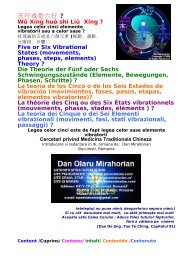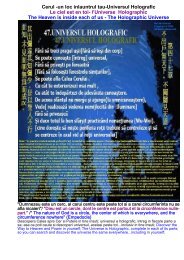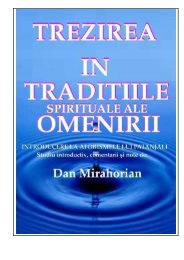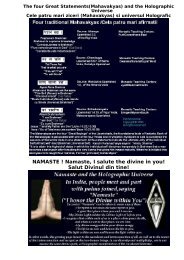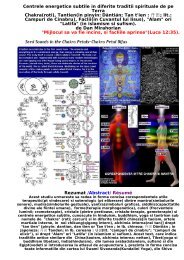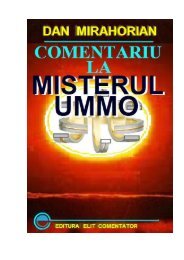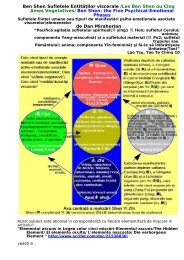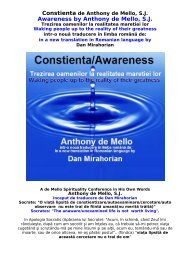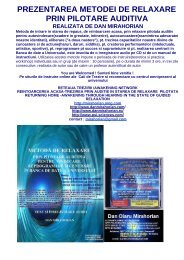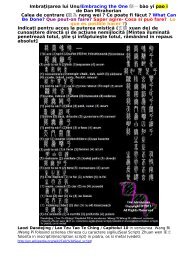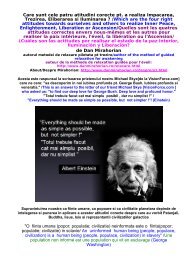Udana Vayu: localizare :gat si cap; centru ... - Dan Mirahorian
Udana Vayu: localizare :gat si cap; centru ... - Dan Mirahorian
Udana Vayu: localizare :gat si cap; centru ... - Dan Mirahorian
Create successful ePaper yourself
Turn your PDF publications into a flip-book with our unique Google optimized e-Paper software.
and M.I.Podgoretsky experimentally determined that when neutrons are pas<strong>si</strong>ng<br />
through spin-polarized targets, a preces<strong>si</strong>on of neutrons arises. The measured<br />
magnitude of preces<strong>si</strong>on has shown that the field which caused that preces<strong>si</strong>on has to<br />
be thousands of times stronger than the magnetic field of the target's nuclei [14]. In<br />
the USA the A.D.Krisch group repeatedly observed anomalies produced by spinpolarized<br />
protons [15]. In France, in experiments with 3He, it was found that the heatconduction<br />
of helium unusually depends on the state of nuclei spins [16]. (This list can<br />
be ea<strong>si</strong>ly continued.)<br />
In 1977, A.C.Tam and W.Happer experimentally discovered that two parallel circularly<br />
polarized laser beams mutually attract or repel depending on mutual orientation of<br />
their circular polarization [17].<br />
In 1966 the K.N.Perebeynos group demonstrated an experimental communication<br />
system in which the transmitter and the receiver were constructed as rotating masses.<br />
Transmitted information could be recieved even when the receiver was shielded by<br />
mas<strong>si</strong>ve screens. The method applied was interpreted as the generation and reception<br />
of gravitational waves [18].<br />
In spite of the seeming diver<strong>si</strong>ty, all of the experiments con<strong>si</strong>dered above have a<br />
certain resemblance: all of the mentioned effects are demonstrated by objects with<br />
spin or angular momentum. As was already noted, probably the first experimenter who<br />
made a major investi<strong>gat</strong>ion of effects demonstrated by spinning objects was<br />
N.A.Kozyrev. It is also necessary to note A.I.Veinik's research work. A.I.Veinik made<br />
tens of types of generators based on rotating masses. These generators could change<br />
their weight (Very slightly. If a mass ~1 kg is rotating with the angular velocity ~<br />
20.000 rpm then the "inner force" ~30*10 -5 N.), and their "chronal" fields could affect<br />
practically all phy<strong>si</strong>cal and biological objects and could not be shielded by "usual"<br />
screens [4]. It is also useful to note V.M.Yurovitsky's patented generators which are<br />
based on spinning magnets. V.M.Yurovitsky was the first who pointed out that many<br />
phenomena could be explained as a result of manifestation of long-range fields<br />
generated by spin or angular momentum den<strong>si</strong>ty. Later generators based on<br />
mechanically rotating magnets were developed by V.V.Bobyr and many others. As a<br />
result of a series of experiments conducted in the Institute of Material Research<br />
("Institut problem materialovedeniya" in rus<strong>si</strong>an) (Kiev, Ukraine) it was established<br />
that the emanation produced by this sort of generator is able to change the inner<br />
structure of any substance (it's spin structure). It was also established that an identical<br />
change of the structure of various substances can be achieved by "sen<strong>si</strong>tives"<br />
("psychics,") and could not be achieved by the use of other known technologies. The<br />
emanations of the developed generators was interpreted as tor<strong>si</strong>on radiation [19].<br />
In other series of experiments conducted in the Institute of Material Research, the<br />
influence of the tor<strong>si</strong>on radiation on various photographs was investi<strong>gat</strong>ed. It was<br />
established that by the use of this method it is pos<strong>si</strong>ble to transmit information from<br />
one point of space to another [20]. (Probably the first researchers to apply this method<br />
were Albert Abrams, Curtis Upton, William Knuth, and George De La Warr.) The<br />
experimental research conducted in the Institute of Material research and at other<br />
scientific organizations was managed by the Center of non-conventional technologies<br />
under the USSR Science and Technics State Committee. These investi<strong>gat</strong>ions were<br />
based on the so called "Theory of phy<strong>si</strong>cal vacuum" developed by rus<strong>si</strong>an phy<strong>si</strong>cist<br />
G.I.Shipov.<br />
G.I.Shipov used a geometry of absolute parallelism (A 4 ) with an additional 6<br />
rotational coordinates, and on the strict level it showed that the movement of any<br />
object should be described by 10 movement equations but not by 4 equations as it is<br />
in Einstein's GR. From Shipov's vacuum equations, every known fundumental phy<strong>si</strong>cal<br />
equation (Einstein's, Young-Mills', Heisenberg's, etc.) can be deduced in completely<br />
geometrised form. G.I.Shipov showed that be<strong>si</strong>des the two known long-range phy<strong>si</strong>cal<br />
fields - electromagnetic and gravitational - there exists third long-range field<br />
posses<strong>si</strong>ng <strong>si</strong>gnificantly richer properties: the tor<strong>si</strong>on field. The tor<strong>si</strong>on field is an<br />
extremely unusual entity. First of all, the upper limit for the speed of tor<strong>si</strong>on waves is



